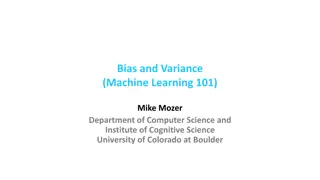Understanding Experimenter Bias in Research Studies
Experimenter bias occurs when researchers introduce their own biases into an experiment, potentially impacting the outcome. This bias can manifest in various ways, such as manipulating results or selecting participants who confirm preconceived notions. Through examples in studies about toddler sleep patterns and student athletes' nutrition, the risks of experimenter bias are highlighted. The content also engages readers to create their own experimenter bias scenarios for discussion. Recognizing and addressing experimenter bias is critical for maintaining the integrity and validity of scientific research.
Download Presentation

Please find below an Image/Link to download the presentation.
The content on the website is provided AS IS for your information and personal use only. It may not be sold, licensed, or shared on other websites without obtaining consent from the author. Download presentation by click this link. If you encounter any issues during the download, it is possible that the publisher has removed the file from their server.
E N D
Presentation Transcript
What is Experimenter Bias? Experimenter bias is when a researcher or scientist introduces bias into an experiment. Some examples of experimenter bias include manipulating results by choosing groups who act in a certain manner or encouraging participants to respond in a certain way. Experimenter Bias 1
Example of Experimenter Bias Scientists are studying how the length of nighttime sleep affects how long of a nap a toddler will take during the day. Scientists believe that the longer a toddler sleeps at night, the better they will sleep during the day because they are in a rested state. Their belief is, if they are overtired and worn out, they will not sleep well. In the scenario to the right, there are a few different ways that researchers could introduce bias into the experiment. What do you think is a bias that they could introduce into the study? Experimenter Bias 2
Example #2 of Experimenter Bias In this example, scientists are studying how the nutrition of student athletes affect their performance in sports. Scientists believe that eating well-balanced meals will increase the students' sports performance by increasing their speed and agility. In the scenario to the right, there are a few different ways that researchers could introduce bias into the experiment. What do you think is a bias that they could introduce into the study? Experimenter Bias 3
In groups, you will work together to come up with your own experimenter bias example. Write this scenario on chart paper to share with the class when it is time. Your Turn! Experimenter Bias 4
Discuss! Experimenter Bias Problems Experimenter Bias 5
Multiple Choice Researchers choose students who read a lot in their free time and do well academically. Researchers are researching links between the amount of time students spend reading for fun and overall grades of core academic subjects. Researchers believe that students who read more outside of school will have better grades in core subject areas. Which of the following would be considered an experimenter bias in this experiment? Researchers choose students at random to participate in this experiment. Researchers have a control group. Researchers use an independent variable in the experiment. Experimenter Bias 6
Your Turn! You will work on a multiple choice question quiz independently at this time. Experimenter Bias 7























